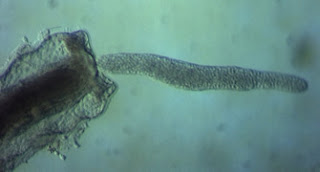Discovered in 1851, the Buddenbrockia worm has long confounded scientists--it seems like a worm, but has some very unworm-like characteristics. Unlike similar looking creatures, such as nematodes, the Buddenbrockia's body does not have separate organs. Its insides are totally symmetric. According to Professor Peter Holland of Oxford University,Aeos Department of Zoology as quoted in Physorg.com, "It doesn,Aeot have a left or right side or a top or bottom ,Aei we can,Aeot even tell which end is the front!...Seen in cross section it is completely symmetrical so no way is ,Aeoup,Aeo and no direction is ,Aeoforward,Aeo."
In order to figure out exactly what kind of creature the Buddenbrockia is, Holland and a group of colleagues compared 50 of its genes with those of other animals. Their findings were truly surprising: the Buddenbrockia isn't a worm at all but actually a close relative of jellyfish and sea anenomes. Said Holland, "It is one of the most striking examples of convergent evolution you will ever see ,Aei we are not talking about the convergent evolution of individual organs or body parts, such as eyes or wings, but of the whole body shape."

It's not what it looks like. It's just convergent evolution.
Holland made a name for himself in the late 1990's analyzing the genetic make up of Twinkies. Turns out they just look like loaves of bread, but are actually more closely related to Sno-Balls and Ho-hos.





